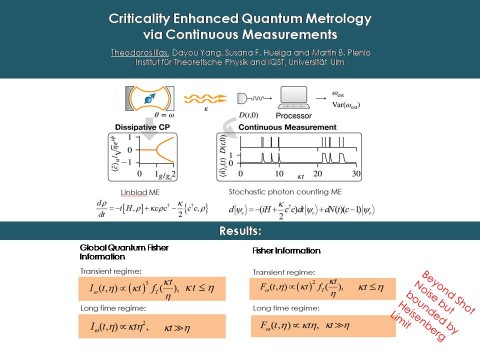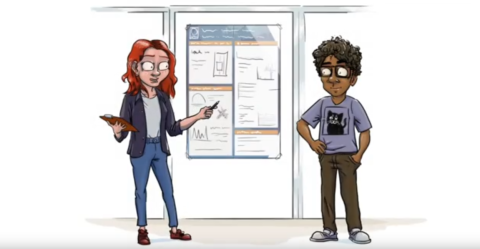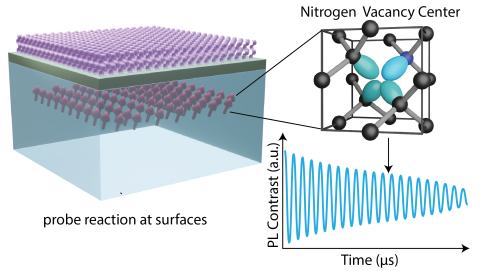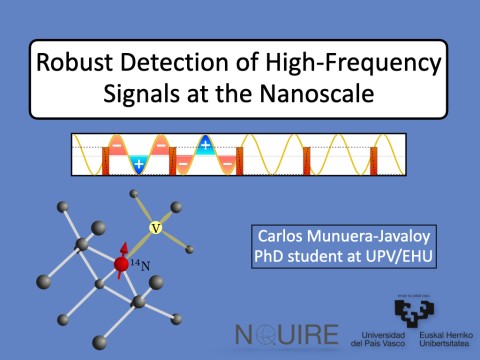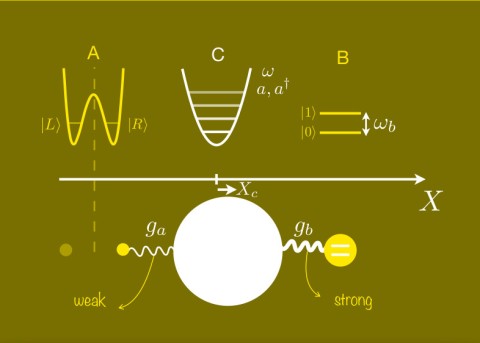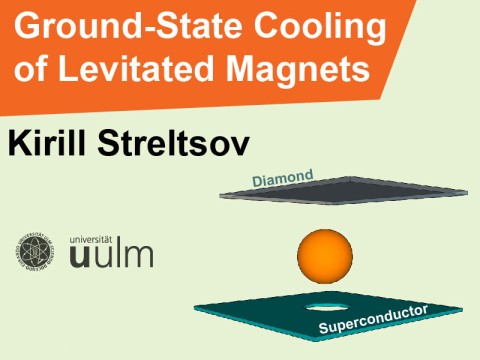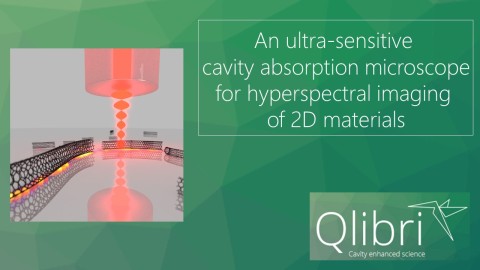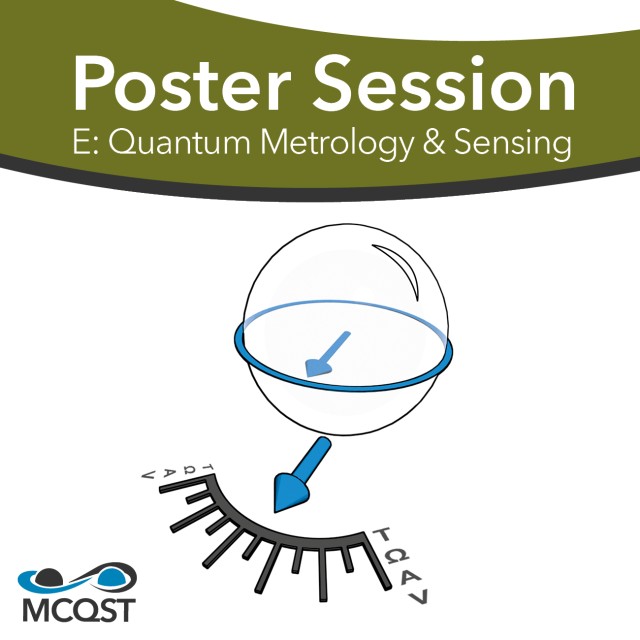
E. Quantum Sensing & Metrology
Poster Session I | All posters are presenting
Monday, 19 July 18:00 - 19:30 CEST
Poster Session II | All posters are presenting
Wednesday, 21 July 11:00 - 12:30 CEST
Abstract
Criticality Enhanced Quantum Metrology via Continuous Measurements
Metrology, i.e., the precise estimation of unknown parameters, plays a crucial role in fundamental science and beyond. Quantum metrology exploits quantum mechanical laws which, given a specific amount of resources (typically the number of particles and the interrogation time), lead to a more precise estimation of parameters than classical metrology. Systems undergoing quantum phase transitions constitute promising candidates for quantum metrology, as small variations of physical parameters lead to drastic changes of the system properties. In this work, we consider metrology via detecting the photons emitted by an open quantum system, which is prepared near a dissipative phase transition and is governed by the unknown parameter. We study the role of quantum criticality by calculating the quantum Fisher information of the system and the monitored environment, as well as the Fisher information for photon counting.
Authors: Theodoros Ilias, Dayou Yang, Susana F.Huelga, Martin B.Plenio
Affiliations: Institut für Theoretische Physik and IQST, Universität Ulm
E.2 Joachim Leibold
Technical University Munich
Abstract
Nanoscale spectroscopy with a diamond quantum sensor
Nitrogen-vacancy (NV) centers in diamond have been shown to be exceptional atomic scale quantum sensors for magnetic fields. Here we use an ensembles of NV centers to detect nuclear magnetic resonance (NMR) signals on the nanoscale. To extract the frequency of the Lamor precession of nucelar spins, we exploit NV-based correlation spectroscopy. With this technique the group was able to probe nanoscale layers, and establish a valuable tool for surface and materials science. Furthermore the technique can be employed to probe the structure of atomically thin materials (2D materials) and might open the way to probe the quantum mechanical effects on the nanoscale such as the spin-Hall effect.
Authors: Joachim Leibold (1), Kristina Liu (1), Roberto Rizatto (1), Andreas Stier (2), Hans Hübl (3), Dominik B. Bucher (1)
Affiliations: (1): Departement of Chemistry, Technische Universität München (2): Walther Schottky Institut and Physik-Departement, Technische Universität München (3): Walther Meißner Institut und Physik-Departement, Technische Universität München
Abstract
Surface NMR using quantum sensors in diamond
Characterization of the molecular properties of surfaces under ambient or chemically reactive conditions is a fundamental scientific challenge. Nuclear magnetic resonance (NMR) spectroscopy would be the ideal technique, however it lacks the sensitivity to probe the small number of spins at interfaces. Here we use nitrogen vacancy (NV) centers in diamond as quantum sensors to optically detect NMR signals from chemically modified thin films. Aluminum oxide (Al2O3) layers, common supports in catalysis and materials science, are prepared by atomic layer deposition and are subsequently functionalized by phosphonate chemistry to form self-assembled monolayers (SAMs). The surface NV-NMR technique detects NMR signals from the monolayer, indicates chemical binding, and quantifies molecular coverage. In addition, it can monitor in real-time the formation kinetics at the solid-liquid interface. This work demonstrates the capability of NV quantum sensors as a surface-sensitive (femtomole) NMR tool for in-situ analysis in catalysis, materials and biological research.
Authors: K. S. Liu (*1), A. Henning(2), M. W. Heindl(1,2), R. D. Allert(1), J. D. Bartl(3), I. D. Sharp(2), R. Rizzato(1), D. B. Bucher(1)
Affiliations: 1) Department of Chemistry, Chair of Physical Chemistry, Technical University of Munich 2) Walter Schottky Institute and Physics Department 3) Department of Chemistry, WACKER-Chair for Macromolecular Chemistry, Technical University of Munich
E.4 Thomas Luschmann
Walther-Meißner-Institut
Abstract
Mechanical frequency control in inductively coupled electromechanical systems
Nano-electromechanical systems link mechanical motion to the highly successful field of superconducting quantum circuits by implementing, in the limit of weak coupling, the opto-mechanical interaction Hamiltonian at microwave frequencies. Recently, inductive coupling schemes with large coupling rates based on partially suspended superconducting interference devices (SQUID) have been demonstrated. Such systems are expected to allow for the exploration of phenomena beyond the linearized opto-mechanical interaction. We present results of an investigation into the impact of the microwave circuit on the mechanical resonance frequency. The experimental data quantitatively corroborates theoretical predictions for SQUID-based electromechanical systems. In addition, we observe a residual field dependent tuning of the mechanical resonance frequency, which we attribute to an effective coupling between the atomic lattice and the superconducting vortex lattice present the magnetic field biased nanostring.
Authors: T. Luschmann(1,2,3), P. Schmidt(1,2), F. Deppe(1,2,3), A. Marx(1), A. Sanchez(4), R. Gross(1,2,3) and H. Huebl(1,2,3)
Affiliations: (1) Walther-Meißner-Institut der Bayerischen Akademie der Wissenschaften, Garching, Germany (2) Technische Universität München, Munich, Germany (3) Munich Center for Quantum Science and Technology (MCQST), Munich, Germany (4) Universitat Autonoma de Barcelona, Bellaterra, Catalonia, Spain
Abstract
Robust Detection of High-Frequency Signals at the Nanoscale
We present a method relying on shortcuts to adiabaticcity to achieve quantum detection of high-frequency signals at the nanoscale in a robust manner. Our protocol delivers tailored amplitudes and frequencies for control fields that, firstly, enable the coupling of the sensor with high-frequency signals and, secondly, minimize errors that would otherwise spoil the detection process. To exemplify the method, we particularize to detection of signals emitted by fast- rotating nuclear spins with nitrogen-vacancy (NV) center quantum sensors (1). 1. C. Munuera-Javaloy, Y. Ban, X. Chen, and J. Casanova, Phys. Rev. Applied 14, 054054 (2020).
Authors: Carlos Munuera-Javaloy(1), Yue Ban (1, 2), Xi Chen (1, 3) , and Jorge Casanova (1, 4).
Affiliations: 1. Department of Physical Chemistry, University of the Basque Country UPV/EHU, Apartado 644, 48080 Bilbao, Spain. 2. College of Materials Science and Engineering, Shanghai University, 200444 Shanghai, China. 3. International Center of Quantum Artificial Intelligence for Science and Technology (QuArtist) and Physics Department, Shanghai University, 200444 Shanghai, China. 4. IKERBASQUE, Basque Foundation for Science, Plaza Euskadi 5, 48009 Bilbao, Spain.
Abstract
Enhancing Linear Interactions in Optomechanical Systems
We discuss two strategies to enhance the interaction between massive mechanical oscillators, e. g. levitated nanoparticles, when they interact via a weak force that can be linearized, like Casimir or gravity. First [1], we show that suitably modulating the trapping frequency of the particles leads to squeezing of their mechanical degrees of freedom, which in turn enhances the interaction between the oscillators. Importantly, the protocol can be reversed to reduce the amount of single-mode squeezing while retaining the generated entanglement. In this way, we reduce the environmental sensitivity gained with the squeezing and protect the generated entanglement. Second [2], we show that a massive mediator can be used to enhance the interaction between two smaller systems. At suitably chosen points in time, the mediator disentangles from the test particles, while the mediated entanglement survives. Remarkably, the mediator system does not need to be cooled down to a pure state and can remain thermal. This opens the door to employing systems of sizes bigger than those that can be cooled down to the ground state for experiments involving entanglement. [1] F. Cosco, J. S. Pedernales, and M. B. Plenio, Enhanced force sensitivity and entanglement in periodically driven optomechanics, Phys. Rev. A 103, L061501 (2021) [2] Julen S. Pedernales, Kirill Streltsov, and Martin B. Plenio, Enhancing Gravitational Interaction between Quantum Systems by a Massive Mediator, arXiv:2104.14524
Authors: Julen S. Pedernales, Francesco Cosco, Kirill Streltsov, Martin B. Plenio
Affiliations: Institut für Theoretische Physik und IQST, Albert-Einstein-Allee 11, Universität Ulm, D-89081 Ulm, Germany
Abstract
Quantum sensing of 2D materials using nitrogen vacancies in diamond
Authors: Riccardo Silvioli 1, Martin Schalk 1, Pedro Soubelet 1, Katrin Schneider 1, Michele Bissolo 1, Dominik Bucher 2, Andreas V. Stier 1, Jonathan Finley 1
Affiliations: (1) Walter Schottky Institut, Technische Universität München, Garching, Germany (2) Chemistry Department, Technische Universität München, Garching, Germany
Abstract
Ground-State Cooling of Levitated Magnets
We present a ground-state cooling scheme for the mechanical degrees of freedom of mesoscopic magnetic particles levitated in low-frequency traps. Our method makes use of a binary sensor and suitably shaped pulses to perform weak, adaptive measurements on the position of the magnet. This allows us to precisely determine the position and momentum of the particle, transforming the initial high-entropy thermal state into a pure coherent state. The energy is then extracted by shifting the trap center. By delegating the task of energy extraction to a coherent displacement operation, we overcome the limitations associated with cooling schemes that rely on the dissipation of a two-level system coupled to the oscillator. We numerically benchmark our protocol in realistic experimental conditions, including heating rates and imperfect readout fidelities, showing that it is well suited for magnetogravitational traps operating at cryogenic temperatures. Our results pave the way for ground-state cooling of micron-scale particles. Phys. Rev. Lett. 126, 193602 (2021)
Authors: Kirill Streltsov, Julen S. Pedernales, Martin B. Plenio
Affiliations: Institut für Theoretische Physik und IQST, Albert-Einstein-Allee 11, Universität Ulm, D-89081 Ulm, Germany
Abstract
EDMR of NV Center Ensembles in Diamond: Optimizing the Electrical Readout
In contrast to the traditionally purely optical readout of diamond color centers in quantum sensing, nitrogen-vacancy centers can also be read out electrically. This relatively new technique enables significant miniaturization of NV-based magnetometers compared to devices based on ODMR. However, the electrical readout is much less well characterized and often behaves significantly different from ODMR. In this work we present a systematic study of the dependence of the EDMR contrast on the excitation wavelength and the properties of the diamond substrate used.
Authors: Lina M. Todenhagen and Martin S. Brandt
Affiliations: Walter Schottky Institut and Physik-Department, Technische Universität München
E.10 Anvar Baimuratov
LMU Munich
Abstract
Exciton g-factor calculations from first principles
The magneto-optical properties of layered transition metal dichalcogenide (TMD) semiconductors are determined by excitons, providing universal aspects for van der Waals heterostructures and devices. We develop theoretical methods for g-factors calculation of excitons in different spin and valley configurations, and provide explicit values for WSe2 monolayer and bilayer excitons composed from electron and hole states at different high symmetry points of the first Brillouin zone. Our calculations go beyond the existing tight-binding models by employing the density functional theory. We compare our theoretical results with experimentally determined g-factors of intravalley excitons and find overall very good quantitative agreement. We also use our theory to interpret peaks in the photoluminescence spectra of bilayer WSe2 and attribute them to intervalley excitons. Generally speaking, the theoretical aspects of our work provide guidelines for magneto-optical studies of single-layer TMDs, homo- or hetero-bilayer systems, and other realizations of TMD-based van der Waals heterostructures.
Authors: Anvar Baimuratov(1), Nikita Tepliakov(2), Stanislav Kruchinin(3), Alexander Högele(1,4)
Affiliations: (1)Fakultät für Physik, Munich Quantum Center, and Center for NanoScience (CeNS), Ludwig-Maximilians-Universität München, Geschwister-Scholl-Platz 1, 80539 München, Germany (2)Information Optical Technologies Center, ITMO University, Saint Petersburg, 197101, Russia (3)Center for Computational Materials Sciences, Faculty of Physics, University of Vienna, 1090, Vienna, Austria (4)Munich Center for Quantum Science and Technology (MCQST), 80799, München, Germany
E.11 Ismail Bilgin
LMU Munich
Abstract
Excitons in Atomically Thin Semiconductors Grown by Chemical Vapor Deposition
Two-dimensional transition metal dichalcogenides (TMDs) and their heterostructures have gained tremendous attention due to their excitonic features such as strong binding, sizable light-matter interaction, moiré physics, and valleytronics. Chemical vapor deposition (CVD) has become an important fabrication technique for these materials to control the size, composition and number of layers and to develop next-generation quantum materials. Here we present the example of CVD-grown monolayer and homobilayer as well as in-plane and vertical heterostructures of TMDs. In particular, we investigate the origin of the excitonic transitions on hBN encapsulated 3R and 2H stacked bilayer WSe2. Contrary to only one K-K exciton transition in the native 2H WSe2 bilayer, we observe two excitonic peaks on 3R samples in photoluminescence and differential reflectivity. Complementary magneto-optical studies in combination with theoretical calculations of exciton g-factors allow us to assign photoluminescence peaks to distinct exciton reservoirs with zero and finite center-of-mass momenta.
Authors: Zhijie Li (1), Jonas Göser (1), Anvar S. Baimuratov (1), Ismail Bilgin (1,2) and Alexander Högele (1,2)
Affiliations: 1-Fakultat für Physik, Munich Quantum Center, and Center for NanoScience (CeNS), Ludwig-Maximilians-Universitat München, Geschwister-Scholl-Platz 1, 80539 München, Germany 2-Munich Center for Quantum Science and Technology (MCQST), Schellingtr. 4, 80799 München, Germany
E.12 Christoph Kastl
Walter-Schottky-Institut, TU München
Abstract
Quantum optoelectronics in materials with topological order
We explore light-matter interactions in topological materials, and we probe the interplay of non-trivial spin-momentum textures, optical excitation, and non-equilibrium spin and charge carrier dynamics.
Authors: Christoph Kastl
Affiliations: Walter-Schottky-Institut, TU München
Abstract
An ultra-sensitive cavity absorption microscope for hyperspectral imaging of 2D materials
We use a tunable high-finesse optical micro-cavity (1) as a versatile and powerful tool to measure absorption in transition metal dichalcogenides (TMDs) down to the parts-per-million level. Our scanning-cavity imaging technique (2,3), where a microscopic mirror is scanned across a larger mirror that hosts the sample, allows to collect absorption images of 2D materials with unprecedented sensitivity, spatially resolved with 2µm resolution and in real time. Our approach can be extended to allow for spectrally resolved measurements and reveals polarization-dependent absorption, implanted defects, crystal foldings, and bubbles. Furthermore, we present our progress to extend this absorption measurements to cryogenic temperatures. References (1) Hunger et al., NJP 12, 065038 (2010) (2) Mader et al., Nat Commun 6, 7249 (2015) (3) Hümmer et al., Nat Commun 7, 12155 (2016)
Authors: I. Amersdorffer(1), M. Nutz(1), J. Noé(1), M. Förg(1), F. Sigger(2), T. W. Hänsch(1), A. Högele(1), C. Kastl(2), T. Hümmer(1)
Affiliations: (1(1): Qlibri project, Faculty of Physics, Ludwig-Maximilians-Universität Munich, Germany (2): Walter Schottky Institute and Physics Department, TU Munich, Garching, Germany


